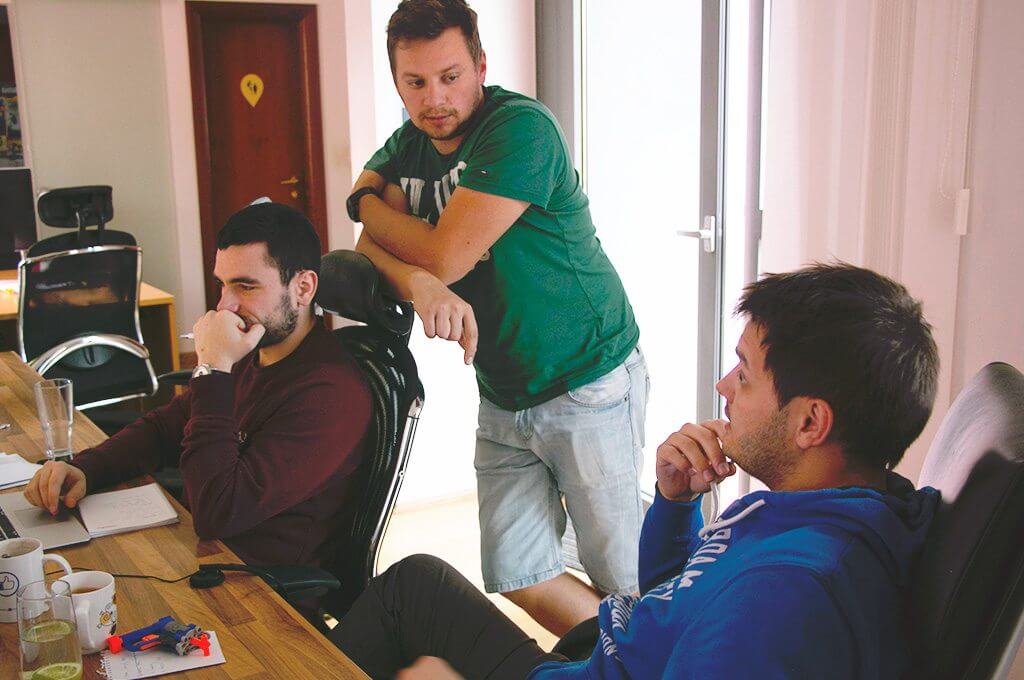
Creating a social media strategy


In a sea of brands battling for users’ attention on social media, the only way to get it is to stand out from the crowd. Here’s what it takes to create a successful and creative social media strategy!
For years, social networks have been the ‘go to’ places for brands to promote their products and services, because they were an easy and fairly inexpensive way to communicate and interact with a broad audience. With more and more brands as well as new social networks entering the game, getting users’ attention has gotten exponentially more difficult.
Now don’t get me wrong, social networks are still the ‘go to’ places, but the time when just about anyone could successfully manage a brand’s social media presence is long gone, you need people who know exactly what they’re doing. If you want to develop a successful brand on social media and get users’ attention, you’ll have to work for it.
OK, let’s not beat around the bush any longer. You’re here to see what lies behind creative and effective social media strategies, so let’s get to it!
EVERYTHING STARTS WITH A BRIEF
The first thing you need to do before you start creating a social media strategy is to take a good look at the project brief. It is the single most important document you have, you’ll use it to steer the entire process in the right direction and to fall back to if you ever get stuck.
Briefs come in a variety of forms, some might offer just the basic information about the goals that need to be achieved and leave the rest to you, while others might give you a complete picture of the brand with everything explained in detail. The more info you can get from a brief, the less additional research you’ll have to conduct, and vice versa.
If you’re creating a social media strategy, try to extract this information from the brief:
- Brand overview
- Main goals
- Core messages
- Type of communication
You can do with less, but this will give you a good enough basis to start creating a social media strategy. And if you can get something more out of the brief, like the analysis of the competition and benchmarks or even buyer personas, that’s a bonus that will save you a lot of time. Whatever the case, you’ll fill all of the gaps in the following steps!
DO YOUR RESEARCH AND DO IT WELL
Now that you have an overview of what’s expected of you, what you have to achieve and which direction you should go with your strategy, it’s time to prepare for that trip. That’s where research comes into play. Research is the second most important step of this entire process, as the information you gather in this phase will affect all of the following steps, so make sure you do it properly. Don’t rush it and half-ass things, because the time you spend to get valuable info during this phase will save you a lot of trouble in the following phases.

When it comes to social media strategies, the first thing you need to do is a complete analysis of the brand. Find out all you can about its backstory, values, audiences and messages, as well as previous campaigns. Get as much info as you can, as this will enable you to get a better grasp of the brand itself.
After you’re done with the brand analysis, shift your focus to content and do a complete audit. See how the brand communicates with its audiences and what’s the main story they’re pushing. Analyse all online and offline platforms a brand is using to get a complete picture of their activities.
The final part of this phase is analyzing benchmarks and defining unique selling points that make the brand stand out from the competition. Get as much information about what the brand does well and what needs to be improved, see what the competition is doing and what needs to be done to get or stay ahead.
Information you acquire during this phase will give you an overview of things that will help you complete the next stages of this process more easily!
FIND OUT WHO YOU’RE TALKING TO
Defining a buyer persona (or personas) is the next step on your path to creating a successful social media strategy. If you conducted your research as thoroughly as I suggested in the previous part, this should be fairly straightforward, as you already gathered all the info you might need to create an archetypal representation of the audience you want to communicate your message to.
To create a buyer persona, you have to analyze demographic and behavioral data you collected about your current and preferred audience, and find the traits that are common among the majority. Also, try to find out how they use products or services the brand is offering and what problems does it solve.
Use all that info to create a realistically described person, your ideal target audience member. Now, you might be asking yourself what’s the point of creating buyer personas if you already have all the data in one place, couldn’t you just use that and skip this entire step? Well, technically you could, but tell me something. Would you communicate with an Excel sheet with 10.000 lines of data, a bunch of graphs and a ton of charts, or Abby who’s 26, lives in London with her parents and a brother, studies law, likes to jog while listening to Drake and thinks stuffed-crust pizza is totally awesome?
Yeah, that’s what I thought, or as Abby would say, I rest my case!
DEFINE KEY OBJECTIVES
After you’ve defined your buyer personas, it’s time to make the main goal you’re trying to achieve a bit more palpable. The simplest way to do it is to take your goal and to break it down into smaller chunks that are easier to manage and reach. Basically, it’s time to get SMART! No, not the Steve Carell action-comedy flick, but the acronym that I’m sure you’ve all heard about:
- Specific – objectives should be clear, detailed and well defined
- Measurable – you have to be able to track and assess your progress
- Achievable – objectives have to be accomplished with available resources
- Relevant – objectives have to matter, be a part of a bigger picture
- Time-bound – objectives gotta have a deadline to keep you on track

Let’s say your main goal is to raise brand awareness. That’s a valid goal, but it’s broad and generic, and that ultimately means you’ll have a hard time achieving it, because you can never be sure how well you’re doing or if you’re doing well at all. By pushing that main goal through the SMART system, you’ll end up with a bunch of smaller, more defined objectives that will guide you to the finish line.
So, instead of having a goal that says ‘raise brand awareness’, you might get an objective that says something like ‘increase the organic reach of Facebook posts by 10% in the next 3 months by improving the visual aspect of posts’. You see how something generic immediately became clearly defined, and now when you look at it, you exactly know what you have to do. And when you have a couple of these objectives lined up, you’ll be well on your way to achieve those main goals!
GET CREATIVE WITH YOUR STORY
You know how I said that research is the second most important step of this entire process? Well, this one is the first! This is where your creative process comes into play and where you actually start creating a social media strategy. Your goal during this step is to define the complete story you plan on telling the audience, and that usually includes a main tagline and messages, as well as proposals for brand activations and other pieces of content you plan to use on social media. In general, try to create a story that has a basis in a brand’s key message, acts as its extension, has the ability to really connect with your audience on an emotional level and ultimately works towards achieving your objectives.
When coming up with the main tagline, take your time and iterate until you find the perfect one, as it will be used as a cornerstone of your entire creative around which all the content you create will revolve. Messages are the main selling points, things that make a brand stand out from the rest, so make sure they are easily understandable and clearly communicate a brand’s benefits. Other pieces of content you plan to use are also all up to you, have fun & play around, just make sure that everything you create fits into the big picture you’re trying to communicate.
Now that you know what the goal of this step is, let’s tackle the elephant in the room — the creative process. There are numerous ways to do it and one could write an entire series of blogs about it, so I won’t go into detail because this blog would never reach its end. I’ll just give you a couple of effective tips that will make the entire process easier.

Select a team with different skills and interests
Before you start with the creative process, assemble a team with different types of specialists. The more different people in your team are, the more different the ideas you come up with.
Take your time
The creative process usually takes some time because ideas can’t be forced, there is no ‘eureka moment’. Good, effective ideas are always a product of hard work, so don’t fret about spending the majority of your time on this phase.
Write down every idea
During your brainstorming sessions, you’ll come up with a ton of ideas. Some will be awesome, others not so much. But no matter how unrealistic, weird or just plain stupid some of the ideas may sound, write them all down. You never know how they might inspire you.
Get a second opinion
Before you finish, invite some new faces to the team and present them your ideas. When you’re working on an idea for a long time, you get emotionally connected to it, so you might not see its flaws. Getting a fresh pair of eyes will help you correct the flaws and make the idea bulletproof.
Have fun
The creative process should be entertaining. If you’re not enthusiastic about your ideas, there’s a slim chance that your audience will be, and let’s face it, they are the ones that will ultimately decide if your strategy is successful. So yeah, have fun!
CHOOSE THE RIGHT SOCIAL MEDIA CHANNELS
I’ll start this with a little warning — just because choosing the right social media channel sounds easy, doesn’t mean that it really is. In fact, this is just as complex as the other steps, because you have to take into account the nature of your brand, your target audience, the message you’re trying to convey and specifics of each social network.
Your target audience is the most important aspect you have to consider when you’re choosing the right channel, as there’s no point in using a social network if your audience is not there. Analyze your buyer personas and you can easily see which social media network they’re using. That’s where you have to be!

In addition to tailoring the choice of social media channels to your defined target audience, make sure you’re also fully aware of different rules and guidelines of particular social networks. For example, Instagram is second to none when it comes to photos, Twitter is all about having the right information at the right time, LinkedIn is ideal for sharing knowledge with other professionals and Facebook is kind of a jack of all trades.
These are just a couple of social media channels you can use, but there’s literally a ton of them to choose from (Tumblr, Pinterest, Youtube, Snapchat, even Whatsapp and Viber), but whichever you end up using, make sure to adapt the story and messages you want to communicate accordingly.
All things considered, take your time and really analyze all of the social networks you plan on using, as well as the elements mentioned above before you make your decision. You‘ll achieve much better results than by just randomly picking a channel!
BUILD A SOCIAL MEDIA PLAN
You’re almost ready to implement your social media strategy. The only thing you’re missing are posts that’ll be published on social media profiles. Creating a social media plan might seem like a straightforward thing to do, but keep in mind that this is your primary way of interacting with the target audience and communicating the message and the story you created in the previous steps.
Without a skillfully crafted social media plan, your social media strategy may fall flat on its face, so to make sure that doesn’t happen, you have to always know:
- What is the main goal you’re trying to achieve
- Who is the target audience you’re communicating with
- What is the key message you’re trying to convey
- What are the rules of the social media channel you’re using
If you absolved all of the things we talked about and defined in previous steps, you have all the information you need to build a killer social media plan. You’ll just need to get your creative juices flowing.
And one more thing, we have a blog about 6 issues Community Managers come across, and covers the topic of creating a social media post in detail, so be sure to check it out if you’re the one tasked with writing it.
MEASURE, ADJUST, REPEAT
The implementation of your strategy doesn’t mean your job here is done, there’s always something you can do to make it better. You see, creating a social media strategy is not a ‘set it and forget it’ kind of thing and there’s still one extremely important task you must do — measure everything.
OK, I might be going a little overboard with this, you don’t need to measure everything, only the things affecting your main goals and objectives you want to achieve. If your goal is, let’s say, brand awareness, you’ll measure reach, and if your goal is website conversions, you’ll measure the traffic your social media posts generate.

By knowing which variable affects which goal or objective, you can fine-tune and optimize your strategy to achieve even better results, just make sure to do it gradually. Don’t start changing everything at once because you won’t be able to isolate the variable that caused a positive change. Make a small adjustment, then test it out and measure the results. Repeat this process until you hit the sweet spot.
This is where you’ll need to work closely with your digital advertising and analytics specialists, as they can help you navigate through the sea of numbers in social media reports. They can also give you valuable insight based on your goals, objectives, target audiences and social media channels, and that can make planning your next steps much easier!
SHOWCASE YOUR WORK AND RESULTS
OK, if you reached this step, that means you created a successful social media strategy that’s resonating with your target audience and achieving great results. Now let’s put the cherry on top with some shameless self-promotion. Just to keep things straight, this part isn’t exactly crucial for the entire process, you can do without it, but you created something awesome, so why not use it to boost the entire story to a higher level.
So what can you do? Well, there are a lot of possibilities, and they all depend on the goals you want to achieve. If you want to teach others and share your knowledge, write a detailed blog describing how you created and developed your idea. If your results are off the charts, create a case study and submit it for an award.
There are lots of marketing-related festivals that you can enter, and winning an award can really boost your stock and spread the word about the brand. If higher brand awareness is what you want to achieve, give a call to your favorite journalist and see if you can get some free PR.
As I said, there are a lot of possibilities, pick one, pick all, it’s up to you!
ARE WE DONE
Yeah, we’re almost finished, stay with me a bit more. As you can see, this is just a brief overview of the most important steps that go into the creation of a social media strategy, and you can use it as a sort of a guide to help you grasp the entire thing. Truth be told, each of these steps could be easily turned into a full-fledged blog or even a series of blogs that explain all of the details and peculiarities of the process. Now that I think about it, I just might do that in the following months.
So, if you’re interested to learn more about a specific step, hit me up with a topic in the comments and I’ll pop it to the top of the list of blogs I plan on writing next!
We use cookies to personalize and optimize user experience. For more information, visit our Privacy Policy.
